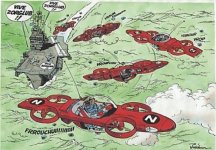- Reaction score
- 8,210
- Points
- 1,160
https://www.defensetech.org/2017/03/23/dp14-hawk/?comp%3D1199477489291%26rank%3D0
I've being irritating the Naval types about them not getting with the programme on manning levels. Now I get to do it with Air Force types.
Up to now I have been confident that nobody would want to get into an aircraft unless it had a reasonably functioning pilot on board willing to go down in flames with the passengers. Now I am not so sure.
I can see this progressing from the insentient (food and ammo) to the insensible (the unconscious) to the non-sensical (idiots wanting to get a better view of the battlespace regardless of personal risk).
Colonel, your Uber-Drone is waiting for you!
Army Eyes Dual-Rotor Drone for Casualty-Evacuation

Dragonfly Pictures Inc.'S DP14 Hawk UAS is part of a U.S. Army effort to one day use drones to evacuate wounded soldiers from the battlefield. Photo: U.S. Army.
POSTED BY: MATT COX MARCH 23, 2017
Dragonfly Pictures Inc.’s DP14 Hawk, a dual-rotor unmanned aerial system, could play a role in a U.S. Army effort to one day use drones to evacuate wounded soldiers from the battlefield.
The DP14 Hawk, which resembles a miniature CH-47 Chinook helicopter, can carry 430 pounds in its six-foot by 20-inch cargo space for about 2.4 hours.
It has a cruising speed of about 82 miles per hour and is capable of flying in crosswinds up to 46 mph.
The DP14 Hawk uses onboard LIDAR, or 3D laser scanning, and advanced algorithms to self-navigate in complex, restricted environments, according to DPI’s website. This includes advanced intelligence for path planning, course corrections, perception, obstacle avoidance, and landing-site selection.
“These cutting-edge capabilities allow the Hawk to fly intelligent autonomous, NLOS, nap-of-earth missions and dynamically adapt to changes in flight conditions and terrain,” according to DPI.

The DP14 is part of a U.S. Army Medical Research and Materiel Command, or USAMRMC, effort to look at alternatives to evacuating casualties in what the Army and Marine Corps calls Multidomain Battlefield, a operational concept designed to prepare the joint force to operate in the domains of land, sea, air, space and cyberspace.
In the future, commanders will employ unmanned systems as force multipliers in mobility- or resource-constrained or denied environments. Future multipurpose unmanned system platforms could assist in medical operations in such environments, Gary R. Gilbert, program manager of the USAMRMC Telemedicine and Advanced Technology Research Center’s Medical Intelligent Systems.
“The growing planned use of unmanned systems and robotics on the future battlefield affords both great opportunities for medical force multipliers as well as significant operational medicine and medical research challenges,” Gilbert said in a recent Army press release.
The TATRC team is developing a UAS research platform that is much smaller than traditionally piloted vertical takeoff and landing aircraft. It has the potential to provide some unique capability for medical logistics compared with larger aircraft. Because of the increased mobility of the smaller aircraft, for example, it requires a much smaller landing zone footprint, which increases the number of available landing zones in difficult terrain.
TATRC is currently testing this UAS research platform to address operational gaps in future medical mission areas and to mature the capability of using UAS for emergency medical resupply and casualty evacuation.
“We are partnering with the U.S. Army Aeromedical Research Laboratory and Dragonfly Pictures Inc. to test this system,” said Gilbert. “With funding from the Defense Health Agency Joint Program Committee for Combat Casualty Care, we are currently initiating a research project to provide a cost-effective UAS research platform for the operational testing and evaluation of emerging enroute care and medical resupply technologies.”
I've being irritating the Naval types about them not getting with the programme on manning levels. Now I get to do it with Air Force types.
Up to now I have been confident that nobody would want to get into an aircraft unless it had a reasonably functioning pilot on board willing to go down in flames with the passengers. Now I am not so sure.
I can see this progressing from the insentient (food and ammo) to the insensible (the unconscious) to the non-sensical (idiots wanting to get a better view of the battlespace regardless of personal risk).
Colonel, your Uber-Drone is waiting for you!





